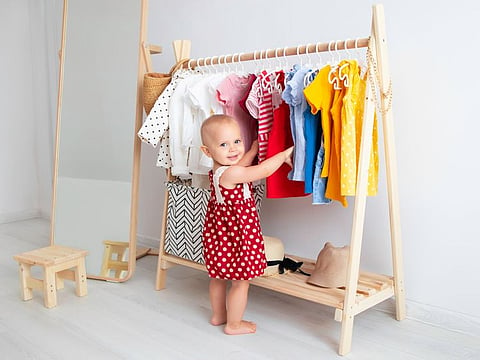A neat freak’s tips on getting rid of old baby clothes
How to manage the constant churn of clothes for growing kids

Having kids means a constant flow of stuff coming in and going out of your house - books, games, toys and, yes, clothes. And even though buying clothes for your growing children can be fun, it can also get pricey. Giving and receiving hand-me-down clothes can be a win-win situation for everyone. The recipients are spared the expense of buying clothes that their child will quickly outgrow, and the donors free up space in their kids' wardrobes - and they feel good about giving stuff away. But for this to work well, organization is required.
Clothes to give away
If you plan to pass along clothing to a friend or relative, create a system. Go through your child's closet at least twice a year (spring and autumn), and create three bags of clothing: items to donate to charity, pieces to hand down and items that are worn out and can be recycled.
For clothes that you're passing down to another child of your own, organize them by size and season and put them in a labeled bin in the younger child's closet. For those you're giving to someone else, ensure the items are clean, folded, arranged by size and labeled when you drop them off. Although it's OK to save a few special items for a child who has not yet been born, do this sparingly. The new baby may not be the same sex as your child, or the new parents may not be interested in hand-me-downs.
Give generously, but don't overburden
All parents, but especially new ones, are overwhelmed in the first few months after their child is born. They have also probably received a fair amount of clothing for their newborn from family and friends. Don't show up to meet the new baby with every piece of clothing your family no longer needs. Instead, first ask the new parents whether they would like your hand-me-downs, and, if so, whether there is anything in particular they're looking for. Keep your offerings to items they will need in the near future, not in five years. It's not worth the hassle for families to store four or five sizes of clothing. Do not pass along stained or damaged items.
I have found that gently used shoes and boots, jackets and outerwear, swimwear and dress clothes are often the perfect items to pass on to others. Seasonal and special-occasion items typically get limited use before a child has grown out of them. And if you can save parents the expense of buying a winter jacket or holiday outfit that will be worn for only one season, that is helpful. Giving them 20 pairs of trousers, however, may not be.
Other pieces that sometimes don't get worn out are sports or specialty items. You might find that the boots you bought for football fit for only one season, or the ski pants and jacket lasted one winter. These can easily be passed along to others. In some cases, you could even pass along clean school or club uniforms.
Create a system to receive - and use
Most parents who store clothes for kids to use in the next year or two think they'll remember what they have and where they put it. This is true whether it's clothing they're keeping for a younger child or something a neighbor or relative gave them as a hand-me-down. But even the most organized among us (ahem, me) have forgotten about something we stashed away until it was too late, and the child had outgrown it. Although it's not a big deal when this happens, it's still disappointing to have gone to the effort to reuse something, then missed the opportunity.
For that reason, the best way to store clothing that can be used by a child within the next year is to keep it in that child's closet, if there's room. The clothing can be folded or hung in a spot designated for items that will "soon" fit or stored in a labeled bin with the size and contents. The same goes for shoes. Put them in the closet with pieces that will "soon" fit, so you don't forget you have the next size up. If there isn't enough space, store the hand-me-downs in labeled bins where they are easy to access. Then you have to remember to look there before you shop for new items.
The key to making the process work well is to sift through items when you receive them, organize them in a way that makes sense, and check the bins at least every season. From newborn to 1-year-old, the sizes are standard, but once you have a toddler, sizes can vary. So even if your child is wearing a 4T, there may be some 5T items that will fit well now.
If all of this sounds like more trouble than it's worth, remember that the constant churn of clothing doesn't last long. Kids grow so quickly from toddler to tween that you'll probably have clothes they have never - or have barely - worn. So why not pass those along to someone you know? Plus, it can be fun for kids to receive hand-me-downs from their cousin or neighbor, and it's always nice to have some backup items to supplement the ones you buy.
As your children grow older, they'll develop their own tastes and wear through pieces less quickly, and just like that, the cycle of items coming in and going out slows down considerably. But while you can, handing down clothing among family and friends is a good way to create less waste, save someone a little time and money, and stay connected.
Nicole Anzia is a freelance writer and owner of Neatnik.
Sign up for the Daily Briefing
Get the latest news and updates straight to your inbox









